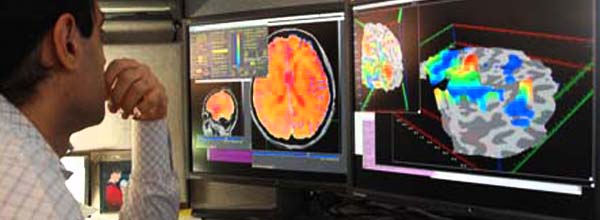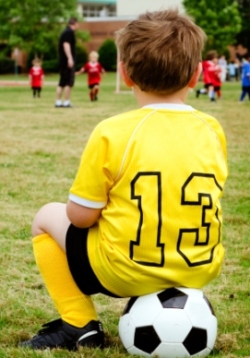Header Rules: Class Action Lawsuit Changes Youth Soccer
Concussion Attorney
by Thomas Cecil
(818) 907-3292
Recently, the United States Soccer Federation (USSF) and other youth soccer leagues agreed to issue new guidelines, including recommending the banning of “headers” for players under 10, in settlement of a class action lawsuit over concussions brought by parents of several youth soccer players.

National Institute of Mental Health, National Institutes of Health, Department of Health and Human ServicesThe lawsuit arose out of mounting evidence that youth soccer players, especially girls, are at risk of significant brain injury from concussions suffered while playing soccer. According to the lawsuit: “soccer ranks among the top sports in the number of concussions per game. Female soccer players have a higher per-game concussion rate than male players.”
Unique to soccer is the use of the head to direct the ball towards another player or to the goal, an action known as a header. The plaintiffs contend:
“Headers” can be a violent striking of the ball, sometimes with such violent impact that spectators wince and the sound of the impact carries through the stands. At least 30 percent of concussions in soccer are caused by heading the ball or by attempting to head the ball and colliding with a player, object, or the ground.
According to the Centers for Disease Control (CDC), a concussion is:
a type of traumatic brain injury—or TBI—caused by a bump, blow, or jolt to the head or by a hit to the body that causes the head and brain to move quickly back and forth. This fast movement can cause the brain to bounce around or twist in the skull, creating chemical changes in the brain and sometimes stretching and damaging the brain cells.
As stated in its Concussion Information Sheet made available as part of the CDC’s Heads Up Concussion program,
Children and teens who show or report one or more of the signs and symptoms listed below—or simply say they just “don’t feel right” after a bump, blow, or jolt to the head or body—may have a concussion or other serious brain injury.
The observed behavioral signs include:
- Appears dazed or stunned.
- Forgets an instruction, is confused about an assignment or position, or is unsure of the game, score, or opponent.
- Moves clumsily.
- Answers questions slowly.
- Loses consciousness (even briefly).
- Shows mood, behavior, or personality changes.
- Can’t recall events prior to or after a hit or fall.
Symptoms include:
- Headache or “pressure” in head.
- Nausea or vomiting.
- Balance problems or dizziness; or double or blurry vision.
- Bothered by light or noise.
- Feeling sluggish, hazy, foggy, or groggy.
- Confusion, or concentration or memory problems.
- Just not “feeling right,” or “feeling down.”
Impact of Youth Sports
Scientific evidence shows that the brain of a child or teenager is more vulnerable to long term damage from repetitive concussions, yet youth and high school sports tend not to provide adequate medical supervision. A New York Times health writer states:
The young brain is especially susceptible to concussion, and sports-related concussions account for more than half of all emergency room visits by children aged eight through 13, according to the National Athletic Trainers’ Association. A child who suffers a concussion is one and a half times more likely to experience another, and those who have had two concussions have a threefold greater risk of the same injury happening again.
According to the class action lawsuit, “about half of all high schools have access to an athletic trainer, but very few have an athletic trainer present on the sidelines or on call to help identify concussions during play.”

In the terms of settlement, the USSF, US Youth Soccer Association (USYSA), and American Youth Soccer Organization (AYSO), among others, will issue new guidance including a recommended ban on headers for U-11 and younger players, and a time limit on heading for U-11 to U-13.
Concussion education for coaches, referees, parents and athletes will be established. Some guidelines will be mandatory – such as the removal of a youth player from practice or a game where the player may have suffered a concussion and the need to follow certain protocols before that player will be allowed to return to play. Return to play and new substitution guidelines are also included in the settlement.
While the results of the class action lawsuit are a step forward in protecting young athletes from serious long term brain injuries, it remains to be seen whether banning heading will appreciably reduce the number of concussions.
Again, from the New York Times:
Among girls, soccer is associated with the highest risk — 6.7 concussions per 10,000 athletic exposures, according to the academy study. Although many focus on the hazards of heading the ball, a new study of high school soccer players found that contact with another player was by far the most frequent cause of concussions among female and male players.
Excellent helpful concussion resources for youth and high school sports, including brain injury basics and a number of relevant fact sheets for identifying and managing concussions, are found at:
CDC Heads Up
http://www.cdc.gov/headsup/index.html
HEADS UP to Youth Sports: Parents
http://www.cdc.gov/headsup/youthsports/parents.html
Concussion Information Sheet
http://www.cdc.gov/headsup/pdfs/youthsports/parent_athlete_info_sheet-a.pdf
Thomas Cecil is a Brain Injury Attorney and Shareholder at our firm. Contact him via email: tcecil@lewitthackman.com, or by phone: (818) 907-3292.
